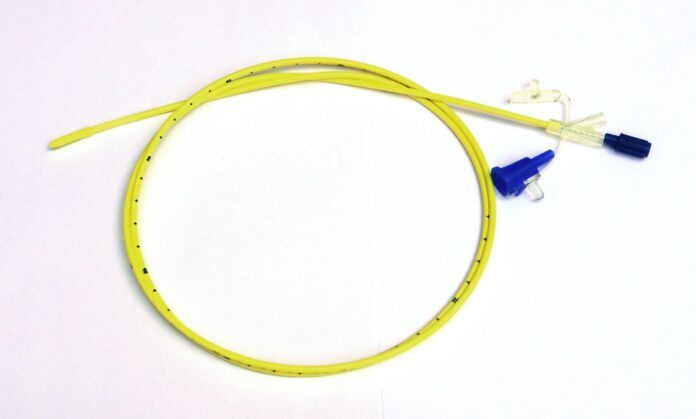Dysphagia is a condition where people have trouble swallowing food or liquids. Dysphagia can be the result of a number of health conditions, including stroke, dementia, traumatic head injuries, multiple sclerosis, cancer, gastroesophageal reflux disease (GORD), cerebral palsy, and other developmental disorders.
Symptoms of dysphagia include experiencing pain during swallowing some foods, or a complete inability to swallow, and feeling hoarse. Coughing and choking during a meal or when drinking can also be a sign of dysphagia. Getting the food back up in the mouth or through the nose can also be a symptom of dysphagia. Additionally, having a persistent feeling of food lodged in the throat or chest, chronic drooling of saliva, a gurgling voice when eating or downing liquids, and an inability to properly chew the food are all signs of dysphagia.
Dysphagia can be of two types: oropharyngeal and esophageal.
Esophageal dysphagia is when you get the feeling of the food getting lodged at the base of your throat or in your chest once you’ve swallowed. Esophageal dysphagia can have several causes. Oropharyngeal dysphagia is when you have trouble moving food from your mouth into your throat and esophagus due to the weakening of your throat muscles. Oropharyngeal dysphagia can be caused by neurological disorders, nerve damage, or cancer.
Left untreated, dysphagia can lead to chronic weight loss and repeated cough and chest infection. Here’s a close look at five ways to manage and treat the condition.
Diet Changes

Diet changes can be used to treat oropharyngeal dysphagia. Your doctor will usually recommend eliminating the foods that are difficult for you to swallow. Instead, your doctor will help you figure out (or refer you to a dietician) a diet that focuses on foods that are easier to swallow. It is critical to make sure you are still following a balanced diet with various food groups. There are several ways to make sure you get all your nutrition even on a limited diet. Consuming fruit and vegetable juice as well as plain water can be a good way of adding vitamins and antioxidants and improving hydration respectively, even on a focused diet.
This professional dentist in Harrisburg also adds that people with dysphagia are more prone to dental caries due to longer contact between the teeth and sugar. They also have a higher risk of periodontal diseases.
Since people with dysphagia can have trouble swallowing liquids too, many dieticians now recommend adding a food-based thickener such as SimplyThick, which makes the liquid thicker and hence easier to swallow. Thickeners ensure the liquid is easier to swallow since the thickened liquid enters the pharynx slowly, letting the path to the lungs stay closed off to prevent choking or aspiration.
Exercise

People suffering from oropharyngeal dysphagia can learn the skill of swallowing over a period of time through specific exercises. A speech therapist is usually the one that can teach techniques to a patient to help strengthen throat muscles, thus helping with successful food swallowing. The therapist can personalize the exercises to your specific challenges by suggesting specific exercises and the duration for each. A speech therapist can be especially helpful to teach children with dysphagia, including children with cerebral palsy and other developmental disorders and learning disabilities.
Feeding Tubes

Feeding tubes help manage severe oropharyngeal dysphagia since otherwise, patients would be at risk of dehydration, extreme weight loss, and malnutrition. Feeding tubes are also used in conditions that leave a patient with temporary dysphagia, where the patients are yet to recover their swallowing ability. The feeding tube can also make taking medication easier.
Feeding tubes can be of two types: a nasogastric tube and a PEG (percutaneous endoscopic gastrostomy) tube. The former is passed through the nose all the way to the stomach and is designed for short-term use. The latter is attached directly into the stomach and is meant for long-term use. Many people prefer PEG tubes since they can be covered by clothing, but they can result in complications much more than the nasal tube. The nasal tube has to be changed and fit into the other nostril after approximately a month. The PEG tube can be used for several months before needing to be changed.
Medication

Esophageal dysphagia can be treated via medication. Esophageal dysphagia is the result of a variety of health conditions, including the presence of foreign bodies and radiation. The medication targets the main, underlying cause of the dysphagia. Medication can include antacids, corticosteroids, proton-pump inhibitors (PPIs), and botox or muscle relaxants to address the specific cause of the dysphagia. PPIs, for example, are prescribed to address indigestion but can also help in dysphagia by improving symptoms due to the narrowing or scarring of the esophagus. Botox can also be used to address dysphagia. The results usually last for about six months. Botox can be used to paralyze the stiff, tightened muscles in the esophagus that stop food and fluids from passing onto the stomach.
Surgery

Esophageal dysphagia can also be treated via surgery, especially if therapy and medication don’t help improve the condition. Surgery can remove the obstruction, if there is one, that’s causing the dysphagia. Alternatively, if the dysphagia is due to a narrow esophagus, then a stent is placed surgically to help open up the esophagus.
The surgical process of removing the obstruction or stretching the esophagus if it is scarred is known as endoscopic dilation. During the process, a thin tube (called an endoscope) with a camera and a lamp at one end is sent into the throat and down to the esophagus. The images from these organs are then displayed externally on a screen. Using these images for reference, a small medical instrument is passed through the esophagus to widen it. The stent, on the other hand, is commonly used in esophageal cancer that can’t be extracted. This is due to the increased risk of causing an inadvertent tear in the already delicate esophagus if it is stretched using an endoscope.
Surgery is also used to treat dysphagia in young children born with a cleft lip or palate.
Dysphagia can cause serious lifestyle and health complications if not managed in time. With the steps given above, you can help yourself or someone you know with dysphagia manage their condition better.




